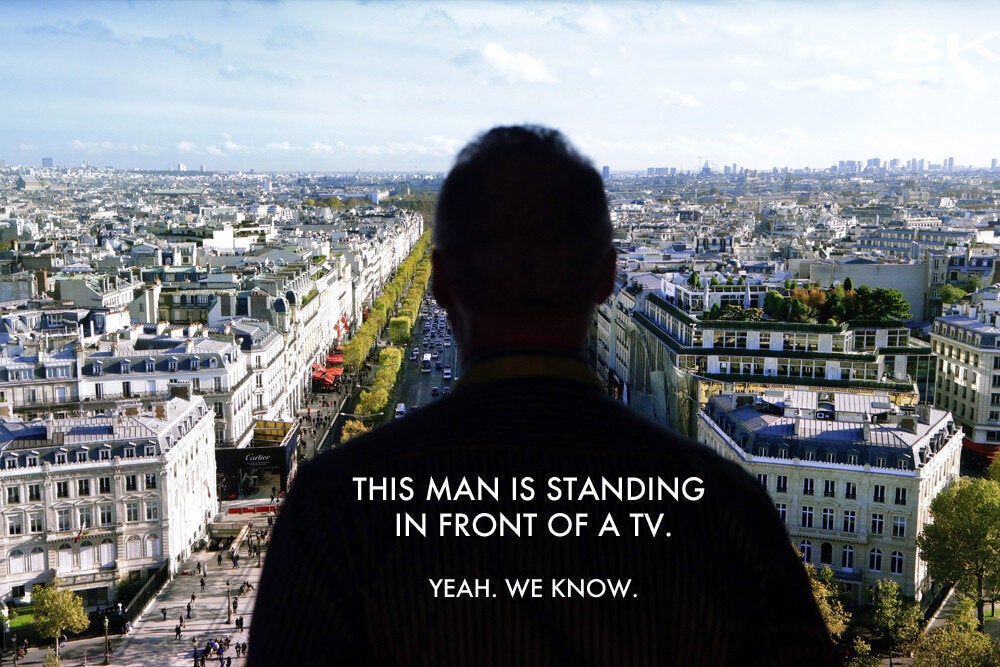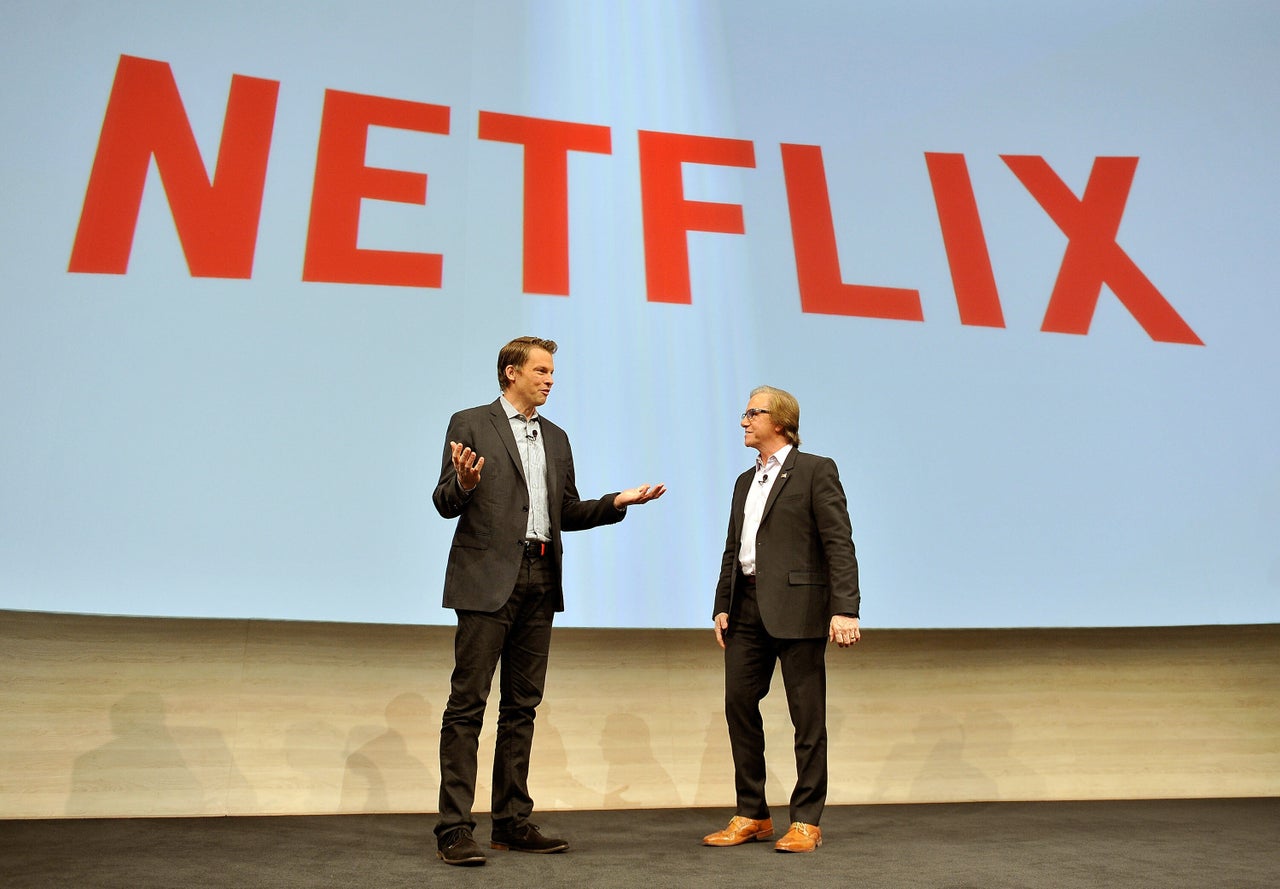Tech Editor Michael Rundle finds out the big trend in TVs at CES 2015 is HDR. Which is... what, exactly?
The 'future of TV' is usually tech media code for 'something cool you won't have in your house for about three years'.
In the past it's applied to everything from DVD to 3D and BluRay. Lately it has applied to 4K, the new resolution standard which is roughly four times sharper than HD and only really visible on screens greater than 50 inches.
Well now that 4K sets are on the market for increasingly reasonable prices -- even if there's not all that much to actually play on them yet -- the TV world has moved on.
Everyone from Netflix to Panasonic is on board. The prototype sets exist. And the TV nerds are already sold.
So welcome - whether you like it or not - to the age of HDR.
Deep breath...

And it's more or less the same deal with TV.
Put simply, it's a way to bring greater definition and variation of colour to images. The process for film-makers involves combining several exposures on one frame - so instead of taking a single shot, a camera might take one focused on low-light areas of the scene, one optimised for the middle range and one on highlights. It then combines them, maintaining smooth variation and detail within shadows and bright lights. To show this, TVs require the ability to selectively show areas of the screen with a much greater level of brightness while still maintaining clarity and - presumably - keeping a cap on energy consumption to within reasonable limits.
To put it another way, the standard measure of brightness is the 'NIT'. Most current TVs reach around 100-300 NITS. HDR TVs will be capable of at least 1,000 NITS, probably thousands more. (The sun at noon is about 1.6 billion NITS, by the way. Just for reference.)
Which is why HDR isn't just a matter of turning up the brightness on your TV, even though it sounds like that. And it's also why the few HDR screens on show at CES 2015 in Las Vegas from Panasonic, Samsung, Sony and LG were resolutely either prototypes, unofficial HDR sets or 'versions' of hardware due out later in the year.
Which is not to say the effect is anything other than impressive. At Panasonic's stand, a prototype HDR set running demo footage showed off a profound level of colour detail, creating a very lifelike image (although admittedly one which benefited from being shown in a very dark room). Panasonic also had a prototype of its first 4K Blu-Ray player, the BT 779, which should also be capable of HDR.
LG had a working HDR prototype at the show - behind closed doors - while Samsung said its flagship S'UHD TV screen will also be HDR compatible - though that too won't be about until next year. It was (again) amazing in person, with warmer colours and richer skies compared to a 'standard' multi-thousand pound 4K television.
That said, there was also a fair amount of smoke and mirrors when it came to HDR at CES. Several stands presented 'comparisons' of HDR and normal TV running side-by-side which were clearly rigged to 'demonstrate' the effect. They may as well have put a black-and-white PC monitor next to the 'HDR' screen, it was that pointless.
Others just showed HDR on pre-recorded footage designed to specifically increase the perception of bright colour on black. As a result it was not -- in this non-expert's opinion -- easy to tell what was so revolutionary about the images based on those demos alone. It was also not easy to tell exactly what content you'll be watching on a screen like this -- or how much you should be prepared to pay for one.
Which is where Netflix comes in.
Netflix Chief Streaming and Partnerships Officer Greg Peters (L) and Sony Electronics President and COO Mike Fasulo (R) speak Sony at a press event at the Las Vegas Convention Center for the 2015 International CES
(Though you'll also probably be a millionaire.)
Netflix told Huffington Post UK at CES that all of its most recent Originals content is made in HDR 4K -- including Marco Polo. And it plans to keep going with its future original content, building a library of HDR that no one else, especially the traditional broadcasters, can match.
"We have a unique role to play here because of the work we are doing with Netflix Originals," the service's Chief Product Officer Neil Hunt told us.
"We are working with people across the entire platform of content from shooting, editing, mastering, grading and colouring to coding and delivery, and with TV manufacturers to render that on the screen. We have the influence to ensure our big content like Marco Polo is captured on HDR and is delivered properly."
Indeed, a trailer for Marco Polo in HDR was playing on a Sony KD-75X940C behind Hunt as he gave his briefing at CES. And it was beautiful. After it cycled around for the 25th time it was really, really obvious how good HDR was, though a bit numbing to the brain. (Another screen running HDR content was in the room, though oddly it was taped up to hide the manufacturer's name -- another sign that the tech is still in its early days commercially, if not technically.)
To that end Netflix also announced at CES that it will begin a new programme to identify TVs with the best Netflix experience - from picture quality to the Netflix app - and give them an official 'Netflix Recommended' label to put on the box, and in stores.
"It's a big significant improvement," Hunt said of HDR. He added that HDR requires 20% more bandwidth than standard TV - up to 18 megabits/second for HDR 4K. He also said that Netflix will actively adjust content if your bandwidth drops during playback -- but that it will drop resolution before it drops HDR. So if you're watching 4K HDR video and your internet connection slows, it will drop to HD standard with HDR, and not down to 4K with regular colours. Hunt said that HD content with HDR is "more satisfying" than 4K without HDR.
Netflix also told us that HDR video could come to tablets like the iPad depending on future hardware revisions, given that their screens are closer to an HDR standard already. Hunt added that he had seen prototypes of HDR tablets in private booths at CES (no names mentioned) and was impressed.
With all that in mind, Netflix knows that the transition to 4K and HDR is going to be a long-haul.
Aside from the lack of screens available to buy right now, there is also a dearth of set-top boxes capable of showing 4K HDR. Hunt said Sony had "promised" a hardware rev for the PS4 that will include a 4K video capability and that they would "expect eventually" for it to support HDR, as one example of where the industry will seek to catch up. But in the meantime any HDR TV will probably have a Netflix app built in, Hunt said, which solves the problem for now.
Netflix also working on a huge refresh of its iPad, TV and web layouts with a greater focus on wide promo images (over box shots) and instant-play video. (Head of Netflix Product Innovation Todd Yellin showed us these interfaces at CES, but we couldn't photograph them. Boo.)
But regardless of the reality of actually watching it today, Netflix's commitment to the new HDR standard is both symbolic ("it gives us a way to lead the industry") - as it was with 4K - and a smart bet given that their feature content will be viewable on Netflix for the conceivable future. "We have to be beginning this transition now…. It allows us to move into a leadership position," Hunt said. "The internet will be out there first." Indeed. Amazon Prime will probably jump on board soon, and broadcasters like Sky will eventually follow.
"In a three- to five-year time frame I'm expecting more than half the televisions sold will be HDR 4K televisions," said Hunt. "More than half of the new content coming onto Netflix will be 4K and/or HDR. Realistically it's the beginning of a transition which will take several years."
Well, first, the industry will have to go away and decide once and for all what HDR is, and how to start rolling it out.
To that end several manufacturers, along with Netflix, Dolby and others have formed the UHD Alliance and will attempt by the end of the summer to nail down the numbers and specs for HDR.
But in reality, right now, there's not much for regular consumers to worry about -- except for the fact that once again if you buy a top-end TV from Curry's, rather than a man in a suit at Selfridges, you're not going to be buying a future-proof telly. In fact, as HDR proves, there is no such thing.
That doesn't mean you'll have a bad TV, of course. Several of the non-HDR TVs at CES - particularly Panasonic's beautiful, though to some extent unfinished 4K curved OLED screen - will offer an amazing experience and probably before HDR sets are even on sale. And let's face it, you can get a great 4K TV for far less even than that.
What it does mean, however, is that if your next TV doesn't have HDR on the box, you'll probably wish it did sooner or later. (Presuming you have a Netflix subscription, that is.)
The good news is that once you have a Smart UHD 4K HDR Curved OLED TV in your lounge, you're set for life.
...
Oh, wait, did we mention 8K?